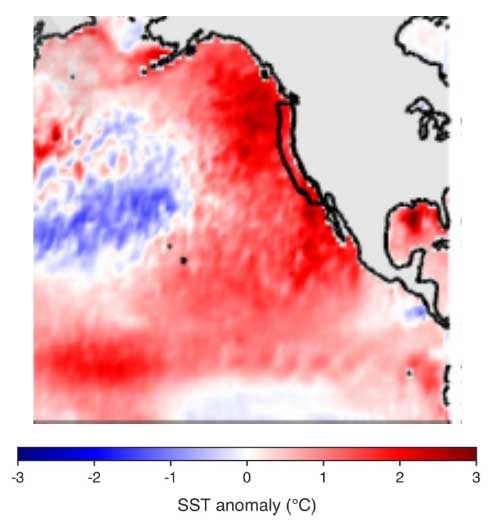August 26th, 2019
Key Findings
- Some aspects of marine heatwaves are more predictable than others.
- NOAA’s NMME ensemble skillfully predicted the initialization of the 2014-2016 California Current heatwave.
- The northward movement of intense sea surface temperature anomalies into the southern California Current was also forecasted successfully in 2016.
- Fluctuations in heatwave strength associated with fluctuations in upwelling winds were not predictable.
- Overall, the large ensemble of forecasts from NMME could be used to identify periods of elevated heatwave risk.
Michael G. Jacox, Desiree Tommasi, Michael Alexander, Gaelle Hervieux, Charles Stock. Frontiers in Marine Science. DOI: 10.3389/fmars.2019.00497
The factors contributing to heatwaves have been the subject of intensive research for many decades. The urgency of this work arises from the steep toll that heatwaves impose on public health, and the prospect that climate change may increase the frequency and severity of these events. Heatwaves also occur beneath the waves, where they can severely affect living marine resources upon which our coastal economies and food supply relies.
The California Current (CC) ecosystem experienced a persistent “ocean heat wave” between 2014 and 2016. (See figure.) Surface ocean temperatures were >2oC (approaching 4o Fahrenheit) above normal for extended periods. The 2014-2016 CC heatwave was associated with a massive coast-wide outbreak of toxic algae, increased marine mammal strandings, heightened seabird mortality, and the temporary closure of several commercially important fisheries.
This research investigated which aspects of the 2014-2016 heatwave were predictable and how forecast skill relates to the mechanisms driving the development and persistence of the heatwave. The authors analyzed predictions from the ensemble of global climate forecast systems contributing to NOAA’s North American Multi-Model Ensemble, which includes predictions developed at GFDL.
Results suggested that some aspects of marine heatwaves are more predictable than others. The NMME ensemble skillfully predicted the initialization of the CC heatwave, which was associated with the southeastward movement of a pre-existing ocean temperature anomaly. Likewise, the predictable northward movement of intense sea surface temperature anomalies into the southern CC was forecasted successfully in 2016.
In contrast, fluctuations in heatwave strength associated with fluctuations in upwelling winds were not predictable. Even when fluctuations were not predictable, however, the large ensemble of forecasts could be used to identify periods of elevated heatwave risk. The forecasts analyzed in this paper are being used to devise anticipatory management strategies aimed at minimizing the impact of ocean heatwaves and other ocean fluctuations on coastal ecosystems and the economies they support.



